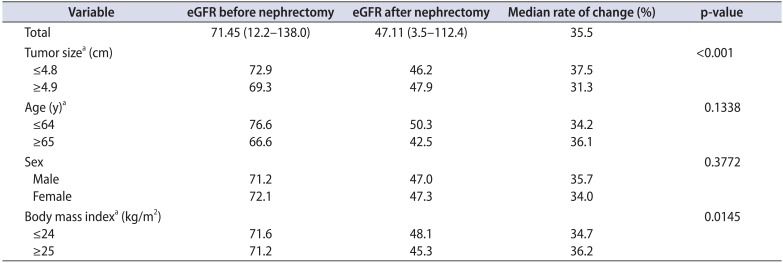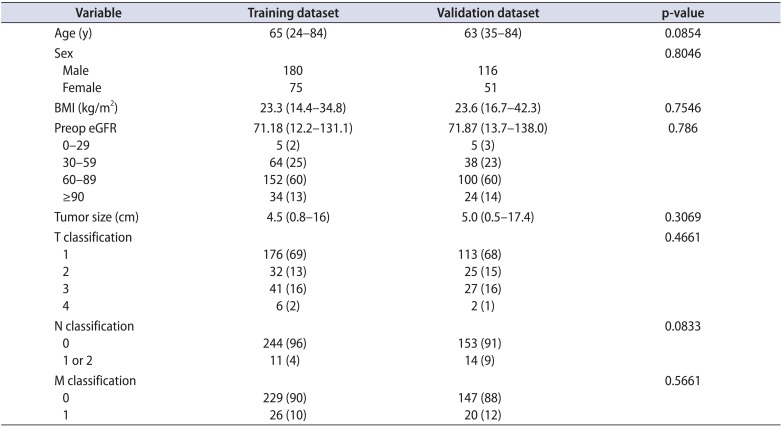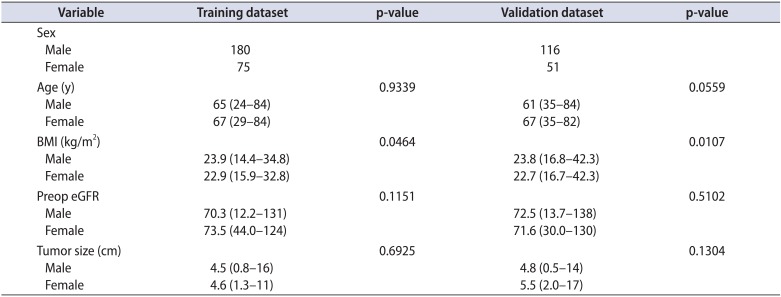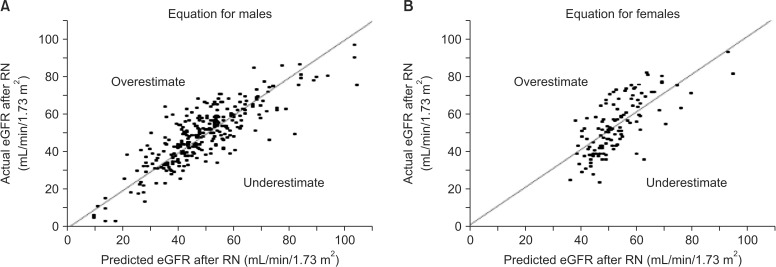1. Levey AS, de Jong PE, Coresh J, El Nahas M, Astor BC, Matsushita K, et al. The definition, classification, and prognosis of chronic kidney disease: a KDIGO Controversies Conference report. Kidney Int. 2011; 80:17–28. PMID:
21150873.

2. Huang WC, Levey AS, Serio AM, Snyder M, Vickers AJ, Raj GV, et al. Chronic kidney disease after nephrectomy in patients with renal cortical tumours: a retrospective cohort study. Lancet Oncol. 2006; 7:735–740. PMID:
16945768.

3. Sun M, Abdollah F, Bianchi M, Trinh QD, Jeldres C, Thuret R, et al. Treatment management of small renal masses in the 21st century: a paradigm shift. Ann Surg Oncol. 2012; 19:2380–2387. PMID:
22322956.

4. Fergany AF, Hafez KS, Novick AC. Long-term results of nephron sparing surgery for localized renal cell carcinoma: 10-year followup. J Urol. 2000; 163:442–445. PMID:
10647650.

5. Lau WK, Blute ML, Weaver AL, Torres VE, Zincke H. Matched comparison of radical nephrectomy vs nephron-sparing surgery in patients with unilateral renal cell carcinoma and a normal contralateral kidney. Mayo Clin Proc. 2000; 75:1236–1242. PMID:
11126830.

6. Huang WC, Elkin EB, Levey AS, Jang TL, Russo P. Partial nephrectomy versus radical nephrectomy in patients with small renal tumors--is there a difference in mortality and cardiovascular outcomes? J Urol. 2009; 181:55–61. PMID:
19012918.

7. Van Poppel H, Da Pozzo L, Albrecht W, Matveev V, Bono A, Borkowski A, et al. A prospective randomized EORTC intergroup phase 3 study comparing the complications of elective nephron-sparing surgery and radical nephrectomy for low-stage renal cell carcinoma. Eur Urol. 2007; 51:1606–1615. PMID:
17140723.

8. Saito H, Matsuda T, Tanabe K, Kawauchi A, Terachi T, Nakagawa K, et al. Surgical and oncologic outcomes of laparoscopic partial nephrectomy: a Japanese multi-institutional study of 1375 patients. J Endourol. 2012; 26:652–659. PMID:
22077693.

9. Van Poppel H, Da Pozzo L, Albrecht W, Matveev V, Bono A, Borkowski A, et al. A prospective, randomised EORTC intergroup phase 3 study comparing the oncologic outcome of elective nephron-sparing surgery and radical nephrectomy for low-stage renal cell carcinoma. Eur Urol. 2011; 59:543–552. PMID:
21186077.

10. Thompson RH. Partial versus radical nephrectomy: the debate regarding renal function ends while the survival controversy continues. Eur Urol. 2014; 65:378–379. PMID:
23921423.

11. Matsuo S, Imai E, Horio M, Yasuda Y, Tomita K, Nitta K, et al. Revised equations for estimated GFR from serum creatinine in Japan. Am J Kidney Dis. 2009; 53:982–992. PMID:
19339088.

12. Levey AS, Stevens LA, Schmid CH, Zhang YL, Castro AF 3rd, Feldman HI, et al. A new equation to estimate glomerular filtration rate. Ann Intern Med. 2009; 150:604–612. PMID:
19414839.

13. Inker LA, Schmid CH, Tighiouart H, Eckfeldt JH, Feldman HI, Greene T, et al. Estimating glomerular filtration rate from serum creatinine and cystatin C. N Engl J Med. 2012; 367:20–29. PMID:
22762315.

14. Efron B, Tibshirani RJ. An Introduction to the Bootstrap. New York: Chapman and Hall;1993.
15. Ohno Y, Nakashima J, Ohori M, Hashimoto T, Iseki R, Hatano T, et al. Impact of tumor size on renal function and prediction of renal insufficiency after radical nephrectomy in patients with renal cell carcinoma. J Urol. 2011; 186:1242–1246. PMID:
21849191.

16. Yokoyama M, Fujii Y, Iimura Y, Saito K, Koga F, Masuda H, et al. Longitudinal change in renal function after radical nephrectomy in Japanese patients with renal cortical tumors. J Urol. 2011; 185:2066–2071. PMID:
21496840.

17. Dawber TR, Meadors GF, Moore FE Jr. Epidemiological approaches to heart disease: the Framingham Study. Am J Public Health Nations Health. 1951; 41:279–281. PMID:
14819398.

18. Frohlich J, Al-Sarraf A. Cardiovascular risk and atherosclerosis prevention. Cardiovasc Pathol. 2013; 22:16–18. PMID:
22502868.

19. O'Donnell CJ, Elosua R. Cardiovascular risk factors. Insights from Framingham Heart Study. Rev Esp Cardiol. 2008; 61:299–310. PMID:
18361904.
20. Ibrahim HN, Foley R, Tan L, Rogers T, Bailey RF, Guo H, et al. Long-term consequences of kidney donation. N Engl J Med. 2009; 360:459–469. PMID:
19179315.

21. Hanes DS, Weir MR, Sowers JR. Gender considerations in hypertension pathophysiology and treatment. Am J Med. 1996; 101(3A):10S–21S.

22. Skafar DF, Xu R, Morales J, Ram J, Sowers JR. Clinical review 91: female sex hormones and cardiovascular disease in women. J Clin Endocrinol Metab. 1997; 82:3913–3918. PMID:
9398686.
23. Berg UB. Differences in decline in GFR with age between males and females. Reference data on clearances of inulin and PAH in potential kidney donors. Nephrol Dial Transplant. 2006; 21:2577–2582. PMID:
16720595.

24. Gibney EM, Parikh CR, Garg AX. Age, gender, race, and associations with kidney failure following living kidney donation. Transplant Proc. 2008; 40:1337–1340. PMID:
18589100.

25. Bello RC, Bello VA, Rosa TT, Junqueira LF Jr, Freitas E, Veiga JP. Male gender and body mass index are associated with hypertension and reduced kidney function 5 or more years after living kidney donation. Transplant Proc. 2015; 47:2816–2821. PMID:
26707294.

26. Lim J, Kong YG, Kim YK, Hong B. Risk factors associated with decreased renal function after hand-assisted laparoscopic donor nephrectomy: a multivariate analysis of a single surgeon experience. Int J Med Sci. 2017; 14:159–166. PMID:
28260992.

27. Mjøen G, Oyen O, Midtvedt K, Dahle DO, Norby G, Holdaas H. Age, gender, and body mass index are associated with renal function after kidney donation. Clin Transplant. 2011; 25:E579–E583. PMID:
21906171.

28. Mulroney SE, Woda C, Johnson M, Pesce C. Gender differences in renal growth and function after uninephrectomy in adult rats. Kidney Int. 1999; 56:944–953. PMID:
10469362.

30. Yokoyama M, Fujii Y, Takeshita H, Kawamura N, Nakayama T, Iimura Y, et al. Renal function after radical nephrectomy: development and validation of predictive models in Japanese patients. Int J Urol. 2014; 21:238–242. PMID:
24118492.










 PDF
PDF ePub
ePub Citation
Citation Print
Print



 XML Download
XML Download